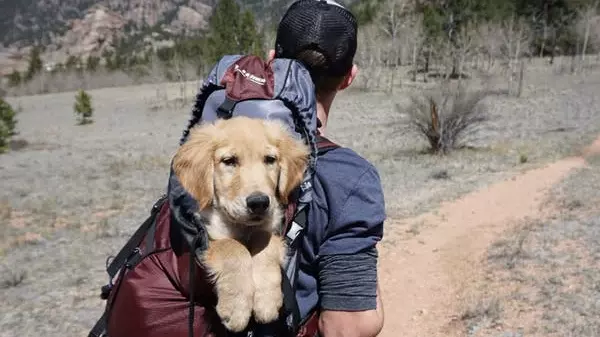Most people believe travelling with dogs is extremely challenging, if not impossible. The majority, therefore, anticipate they’ll have to shell out a fortune to pay for the expenses of dog-sitting their pets while they vacation.
However, I discovered that it’s not as tough as you may think to bring your furry pals along with you on most vacation trips if you do some study and make a few additional preparations.
I wanted to share what I’ve discovered while travelling about this new trend because I’m enthusiastic about pets and travel.
Most Recommended: Best Solo Travel Tip
Table of Contents
What are the things you need while travelling with a Dog?
Do you want to take your dog on a trip? Dogs may be excellent travelling buddies if you consider your dog’s travel requirements. Check out my dog travel packing list to learn how to pack for him in your bag.

Dog Travel Checklist
Here, are the list for the Dog while traveling,
Most Recommended: Latest Yearly, Packing Tips for Traveling Abroad
Road journeys
- ample water and food to last the entire trip.
- Treats because, let’s face it, your dog is a good boy and deserves rewards occasionally.
- Dog litter bags.
- A leash.
- A blanket for your dog to lie down on.
- A favourite bone or toy.
- A recent photograph of your dog (in case you get separated).
- A tag including thorough directions and your mobile phone number.
- If you’re taking planning to be outside in the sun, make sure to apply sunscreen. Sunburns may also occur on dogs.
Campout
- Proof of most recent immunizations.
- An additional collar and leash.
- Clean their wounds with soap and water and keep them dry.
- Comb or brush. These will be useful if your dog picks up objects in the woods while exploring.
- For your dog, get a towel. It’s a good idea to clean your dog off before putting him inside a camper or tent because, believe us, he will become dirty while you’re camping.
- If a tick were to bite him, he would need tweezers.
- He can sleep in a dog bed instead of on the ground.
- If boating is anticipated, wear a life jacket.
How to travel with a dog?
Travelling may be stressful enough without adding dogs to the picture. But when you take your dog on a trip, you need more than just a neck cushion and a travel blanket to ensure their comfort.

In general, animals are accustomed to following certain patterns, so any change in that pattern can be disturbing for both the dog and the owner.
However, it doesn’t follow that travelling with your dog has to be a misery. Read on these dog travel suggestions before you get on the road, and use my helpful checklist of pet travel necessities to be ready for your trip.
How to travel with a dog in the car?
Dogs shouldn’t be let loose in the vehicle
Your dog should ride in a securely fastened crate using a seat belt or another reliable method if you want to ensure it’s safe. Dog restraints or seat belts can help keep your dog from running about the car and distracting the driver, but there is no reliable evidence that they will keep dogs safe in an accident.
Keep those heads in!
Dogs must always be kept safely in the vehicle. Dogs who can push their heads out windows risk getting hurt by flying glass or becoming ill from cold air being forced into their lungs. Never carry your dog in the open pickup truck bed.
Give your pet a lot of breaks for relaxation.
As needed, stop to let your pet use the restroom and engage in some exercise. But never allow your pet out of the vehicle without a collar, leash, or identification tag.
Bring a human companion
Split driving and pet-care responsibilities with a friend or member of your family whenever you can. Knowing someone you can trust is watching out for your dogs can let you use the restroom or buy food at rest breaks.
Never leave your pet in a car alone.
Your dog shouldn’t be left alone in the car for an extended time, regardless of how short the stop may seem. When it’s 72 degrees outdoors, your automobile may go up to 116 degrees inside in only one hour, making heat a severe risk. Even with the windows partially open on an 85° day, your automobile’s interior may reach 102° in just 10 minutes.
Even though your time is guaranteed, things might still go wrong. In as little as 30 minutes, you might return to a 120° vehicle and a dog that has irreparable organ damage or has already passed away.
How to travel with a dog on the plane?
Dogs may have risks when flying.
When deciding whether to fly your pet, we advise you to consider all the risks. Air transport can be especially hazardous for dogs with “pushed in” faces, such as bulldogs, pugs, and Persian cats. They are particularly susceptible to heat stroke and oxygen deprivation due to their small nasal passages.
Think about all your options besides flying. Driving is frequently preferable if you intend to bring your pet on vacation. Your dog will likely be happier and healthier if you leave them in the hands of a pet sitter or boarding kennel if you cannot go by car.
However, there may be times when that isn’t an option, in which case you must choose if the benefits of flying outweigh the downsides.
When flying with a pet, pick the cabin if at all feasible.
Check if your dog can fly in the cabin with you if flying is your only choice for transferring them. For an extra cost, most airlines will let you bring a dog in the cabin. There are restrictions on the number of animals permitted in the cabin, so you must notify the airline well in advance.
Ensure your dog complies with the criteria for size if you are moving them. Some firms can assist you in going through the procedure of travelling with a dog if you become confused by all the requirements.
When transporting your dog through security at the airport, exercise caution.
You and your dog’s carrier must go through the security checkpoint together. Ensure your dog is restrained correctly so you may safely keep it outside its container while it is being x-rayed. Alternatively, you can ask for a special additional inspection that won’t need you to remove your dog from its carrier.
Know the risks of transporting your pet in the cargo hold.
Although most animals transported in an aeroplane’s cargo hold are safe, you ought to be informed that some animals are lost, hurt, or killed on commercial flights every year. Temperatures that are too hot or cold, inadequate airflow, and hard handling are frequently to a fault.
How to travel with a dog on a Cruise/Ship?
Exclusively a few cruise lines allow pets, generally only on ocean trips, except in the case of service dogs. Despite some lines allowing dogs in specific cabins, the majority cage them.
To learn about the regulations of your cruise line and which of its ships provide kennel facilities, get in touch with them in advance. If you have to utilize the ship’s kennels, ensure it is weatherproof and keep an eye on your dog.
How to travel internationally with a dog?
Study the pet travel regulations thoroughly.
There are a variety of international pet travel regulations, just like there are various visa requirements for people travelling to other countries. Your pet might need particular vaccines, and a pet health certificate is frequently needed. A “pet passport” is the term used to describe the set of health and immunization certifications. Don’t forget to find out if exporting pets is prohibited in the nation you are leaving. It’s better to learn this information in advance before flying overseas!
Make Certain Your Dog Has the Necessary Vaccinations
The rabies vaccine is typically necessary for dogs to travel overseas. In some countries where rabies is present, a rabies certificate is often necessary for entry. A rabies vaccine is generally normally necessary for travel to rabies-free nations unless you come from another country. Additionally, several nations demand that your pet undergo a rabies titre test. This test determines the number of rabies antibodies present in your pet’s blood, providing additional proof that they have received the recommended amount of vaccinations.
Look into Your Transportation Options
The simplest method for taking a dog overseas, particularly a bigger one, is to get in your vehicle and drive across the border. If that doesn’t work, a quick boat journey is another simple alternative, where your dog may either go on the outside deck or remain in a kennel or your car or possibly in a pet-friendly cabin for longer voyages.
Think about using a pet delivery service.
As I previously said, you could be obliged to reserve your dog’s travel through a pet transport business if your dog is flying cargo. However, more factors may influence your decision to transfer your dog worldwide through a pet shipping service. A pet transport business knows the documentation and vaccines needed for your pet to go abroad. They may schedule visits with their veterinarians and provide kennels for air travel. Additionally, they will be conversant with the various airline regulations and be aware of the finest flights to transport you where you’re going.
First, train your dog.
It’s essential to ensure that your dog is well-trained before taking it on an international trip. A pet will probably experience a wide variety of surroundings when travelling, from using public transportation to eating in cafes—avoiding adding the requirement to behave nicely when staying in hotels or vacation rentals, such as not barking or having mishaps.
Look into the Canine-Friendly Accommodations at Your Destination
Start looking into dog-friendly accommodations and activities at your destination before making any reservations. Even amongst nations with shared borders, there are vast disparities in the availability of pet-friendly lodging alternatives.
Purchase of Dog Food
Even though it’s ideal for bringing your dog food while travelling, this isn’t always possible, and if you’re gone for a longer duration, you’ll undoubtedly need to purchase additional treats at some point.
Find out if you can bring your dog food before you leave. Additionally, attempt to find out which pet food brands are available in your home country. Many of the most well-known brands are sold in a wide range of nations, so you might be able to give your dog the same brand you do at home.
My Opinion
My trips with my dog are more vibrant and locally oriented, making me explore areas of my destination that I probably never would have otherwise.
My pets encourage me to socialize, travel, appreciate and live in the moment. There’s no finer way to explore a new location than with a dog!
Travelling with your dog will be much easier if you have all the necessary pet supplies and equipment. Why are you holding out? Get ready for your trip, and enjoy it to the fullest.
Frequently Asked Questions (FAQs)
Q. Best way to travel with a dog
A. The easiest method to keep your dog safe and prevent them from disturbing you as you drive and navigate is to put them in kennels. However, you may buy a harness or car seat that connects to your car’s seatbelt system if you’d rather watch your travelling companion closely.
Q. How can I travel with my dog?
A. Driving is typically preferable if you intend to bring your pet on vacation. Your dog will likely be happier and healthier if you leave them in the hands of a pet sitter or boarding kennel if you cannot travel by automobile.
Q. How to travel cross country with a dog?
A. Some tips are:
Consider going digital.
See to it that your pet’s vaccinations are up to date.
Prepare your pet for travel.
Schedule regular rest stops and pit stops in pet-friendly locations.
Your pet should be microchipped.
Use the proper carriers or restraints for safety.
Q. Can a dog travel internationally?
A. You can travel internationally with your dog, yes. Your dog can travel in the cabin or cargo while travelling internationally.
Q. Does a dog need a passport to travel?
A. For their dog, cat, or other pet, owners should make a pet passport, a compilation of all the identification and entry-requirement documents. Travelling with your pet will be safer and more enjoyable if you are informed of the import restrictions.
Q. Can dogs travel in a car for 12 hours?
A. Although it could be challenging, you should attempt to follow your dog’s regular eating and bathroom schedule when you’re travelling. You should give your dog breaks on average every two to four hours for 15 to 30 minutes, and you should aim to drive no more than seven hours per day.
Q. How do I prepare my dog for a long drive?
A. Don’t feed your dog a large dinner right before you leave. Ensure that your dog has eaten at least four hours before your trip. Before you get in the car, take your dog for a walk to prepare him for the journey. He can now relieve himself and stretch his legs.
Q. How often should you stop on a road trip with a dog?
A. The sweet spot, according to many, is a halt every two to four hours for around 15 to 30 minutes.
Q. Can I buy my dog a seat on a plane?
A. Your dog cannot use an additional seat that is offered. In most cases, it is less expensive to transport a dog in this way, essentially as carry-on baggage, than to store it in the airplane’s cargo hold. Pet carriers are regarded as a component of your carry-on baggage.

